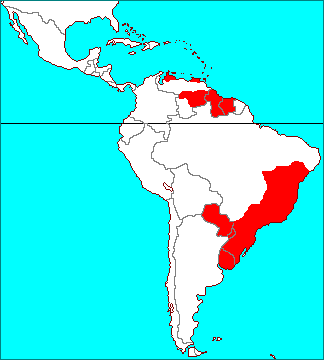
Trinidad, Guyana, Suriname, Venezuela, Brazil, Paraguay, Uruguay, Argentina
Trinidad, Guyana, Suriname,
Venezuela (Sucre, Bolívar, Falcón),
Brazil (Bahia, Espirito Santo, Minas Gerais, Rio de Janeiro, São Paulo, Paraná, Santa Catarina, Rio Grande do Sul),
Paraguay, Uruguay,
Argentina (Misiones)
0 - 1,680 m elevation
Epiphytic
Tillandsia stricta
Tillandsia (Anoplophytum) stricta Solander ex Sims (1813)
- [ Etymology ] strictus in Latin (upright)
- The rosette is composed of narrow leaves covered with few trichomes.
- It resembles Tillandsia montana. Petals of Tillandsia stricta are ligulate, whereas those of Tillandsia montana are ovate.
- [ Width ] 10 cm
- [ Height ] 10 cm
- [ Petal ] Violet
- [ Bract ] Red
- [ Flower ] November - January
- [ Flower ] for 11 days
- [ Cultivar ]
- Rigid form (Leaves are rigid and brittle)
Classification
- [ Genus ] Tillandsia
- [ Subgenus ] Anoplophytum
- [ Variety ]
- albifolia (white leaves)
- caulescens => Tillandsia tenuifolia
- disticha (distichous spike)
- krameri => Tillandsia stricta
- paraguaiensis => Tillandsia recurvifolia
- stricta
- [ Subspecies ]
- piniformis (Spindle form)
- [ Form ]
- nivea (White flowers)
- [ Synonyms ]
- Tillandsia conspersa Miquel (1845)
- Tillandsia krameri Baker (1889)
- Tillandsia langsdorffii Mez (1894)
- Tillandsia monostachya W. Bartram (1791)
- Tillandsia monostachya Vaillant ex Baker
- Tillandsia pulchella Hooker (1825) var. rosea (Lindley) Mez (1894)
- Tillandsia rosea Lindley (1830)
Cultivation
Informations summarized here are based on our experiences, and TrekGEO does not guarantee the results by cultivating in the same or similar conditions described here. Even a species of Tillandsia differs substantially between individuals, and is very sensitive in changes of environments. Applicatons of any idea inspired by this site should be at your own risks.
3rd Plant
- Cultivation condition
- Partial shade, Soaking and misting, Hanging, AC / Heater
- Sep 2025 It keeps growing.
- Up to this point
- Partial shade, Long soaking, Shelving, Summer AC
- Apr 2020 It keeps growing.
- May 2019 Only 2 offsets keep growing.
- Feb 2019 5 offsets began to grow at the base of the inflorescence.
- Nov 2018 It flowered.
- Oct 2018 An inflorescence began to grow.
- Sep 2017 Good condition.
2nd Plant
- Cultivation condition
- Partial sun, Long soaking, Shelving, Indoors
- Sep 2019 It died.
- Mar 2019 2 offsets began to grow at the base of the inflorescence.
- Jan 2019 It flowered.
- Nov 2018 An inflorescence began to grow from a foliages of the clump.
- May 2018 The clump was dispatched to 3-foliage clumps.
- Mar 2018 2 offsets began to grow at the base of the inflorescences of each bloomed foliages.
- Dec 2017 It flowered.
- Dec 2017 Inflorescences began to grow from 3 foliages of the 5-foliage clump.
- Mar 2017 2 offsets began to grow at the base of the inflorescences of each bloomed foliages.
- Jan 2017 It flowered.
- Nov 2016 Inflorescences began to grow from other 2 foliages of the 3-foliage clump.
- May 2016 An offset began to grow at the base of the inflorescence.
- Dec 2015 It flowered.
- Nov 2015 An inflorescence began to grow from a foliage of the 3-foliage clump.
- May 2013 3 offsets began to grow at the base of the inflorescence.
- Mar 2013 It flowered.
1st Plant
- Cultivation condition
- Partial shade, Long soaking, Shelving, Indoors
- May 2008 Roots began to grow.
- Mar 2008 The foliage turned red.
- Oct 2006 Moved to another site. Cultivation condition is almost same as the previous site.
- Aug 2004 The temperature rises above 30 degree C for 40 days, and the highest temperature was over 39 degree C.